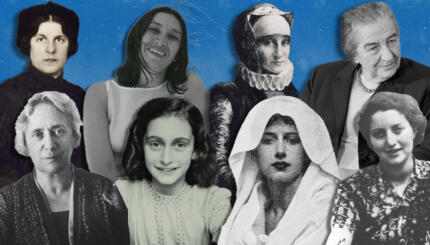There is no conformity for liberal Jewish women in the synagogue when it comes to wearing a head covering. Look around you the next time you go to a bar/bat mitzvah. How many women and post bat mitzvah girls are wearing a kippah? Is the female rabbi wearing any kind of headgear? Does it vary from denomination to denomination? Is there a growing cultural tradition that is evolving in the 21st century? Are Jewish women being shaped by what we wear or don’t wear on the bimah?
Enter Diaspora Girl, a website that sells sassy headcoverings for the girl who wants to “rock” on a Shabbat morning at the local temple. The site asks women to decide between “those flimsy little white things at the door of the shul that look like Thanksgiving turkey decorations” and their affordable and spiritual hip designer hats. If you are a modern Jewish girl who likes the idea of ritual headgear, but you are “cognizant of the fact that traditional kippot look about as cool on women as sandals with black socks look on men” then these hand-made gems are calling you to take action with a credit card.
What is a Diaspora Girl? According to the owner, Rina Barz Nehdar, a diaspora girl is someone who refuses to conform to the mainstream. They have their own thing going on and the power and the chutzpah to stand out from the crowd.
“The women most attracted to my product are women who are trying to find their niche in the Jewish world without giving up their individuality,” writes Nehdar.
Diaspora’s funky and feminine kippot are crocheted from cotton and/or cashmere and are adorned with beads, sequins and ribbons. Each style has a fun name, “Dreamcatcher,” “Japanese Blossom,” Goldilocks and “Belladonna.” Women like choices in their style of headgear. A skullcap by every other name looks and feels ritually different.
Are they cooler to wear than hats or kippot for women? Do they really prevent “hat hair”? Inquiring heads want to know!
When I began leading Shabbat services during rabbinical school, I dressed up for prayer. A weaver from Asheville, North Carolina supplied me with a dozen kippot of various shapes and colors and yarns. No black yarmulkes for me. I am a fashion-conscious female rabbi looking to distinguish myself and my wardrobe from the masculine model. My tallit matches my kippah and sometimes the color of my dress. As a rabbi pioneer on the bimah, I continue to cause a red carpet stir at the Oneg.
Today, when I walk into a reform synagogue, a kippah on a woman is an anomaly. In Conservative synagogues those white doilies are still quite popular. More women wear a tallit and a kippah during a Reconstructionist service. I continue to individuate my synagogue look. By definition, I am a diaspora girl.
My eldest daughter Na’ama wore a kippah and a tallit at her Conservative bat mitzvah in 1985. She has not worn her handmade prayer accouterments for 27 years. Perhaps these funky hip kippot will convince her to be another diaspora girl. It is never too late to begin a trend even in my own family where the heads of three girls lie in the balance. Let’s all go funky! My treat!
bat mitzvah
Pronounced: baht MITZ-vuh, also bahs MITZ-vuh and baht meetz-VAH, Origin: Hebrew, Jewish rite of passage for a girl, observed at age 12 or 13.
chutzpah
Pronounced: KHOOTZ-pah, Origin: Yiddish, nerve, brazenness, presumption, extreme confidence.
kippah
Pronounced: KEE-pah or kee-PAH, Origin: Hebrew, a small hat or head covering that Orthodox Jewish men wear every day, and that other Jews wear when studying, praying or entering a sacred space. Also known as a yarmulke.
mitzvah
Pronounced: MITZ-vuh or meetz-VAH, Origin: Hebrew, commandment, also used to mean good deed.
Shabbat
Pronounced: shuh-BAHT or shah-BAHT, Origin: Hebrew, the Sabbath, from sundown Friday to sundown Saturday.
shul
Pronounced: shool (oo as in cool), Origin: Yiddish, synagogue.
tallit
Pronounced: tah-LEET or TAH-liss, Origin: Hebrew, prayer shawl.



